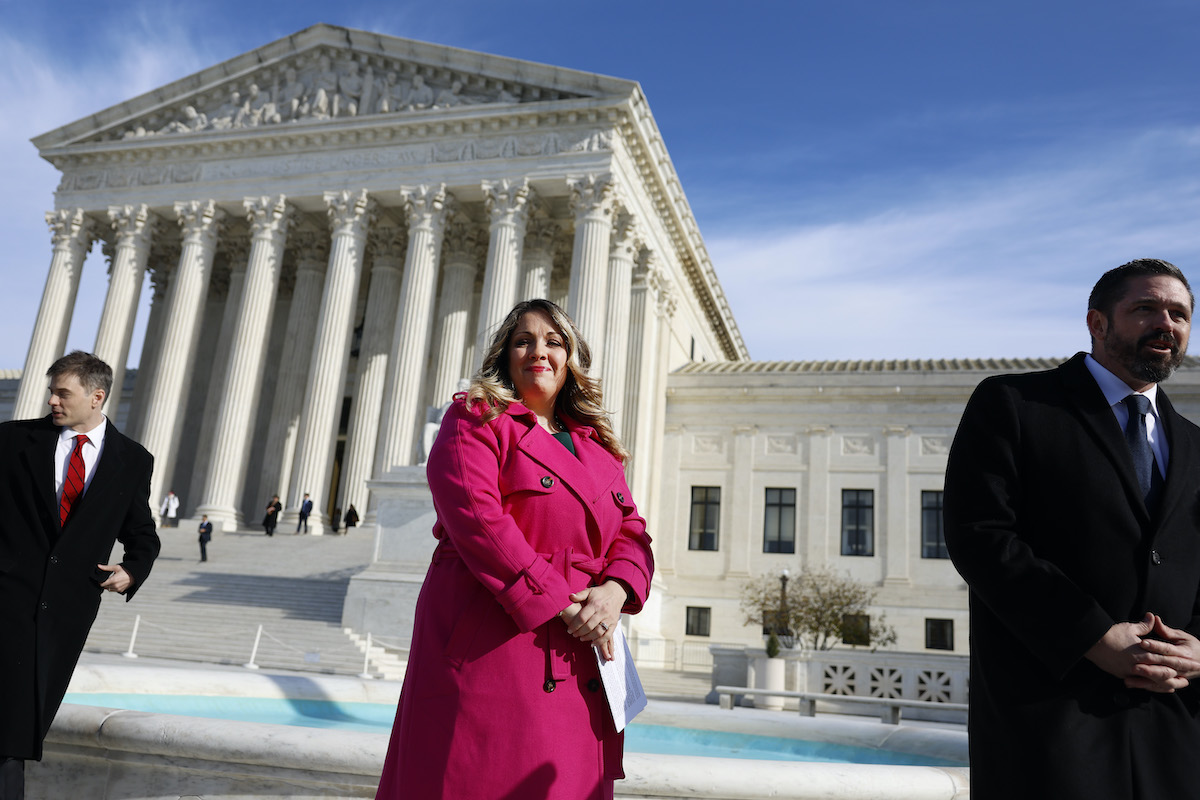Supreme Court conservatives have sided with a Denver designer and evangelical Christian who wanted to make absolutely certain that no one ever forces her to make a website for a same-sex marriage in a devastating 6-3 decision that will enable more widespread, federally sanctioned discrimination against LGBTQ+ people. But as we waited for the inevitable blow, a wild new wrinkle manifested: A man cited in court filings as having requested the designer’s services for his marriage to another man told a reporter that he never asked her to do any design work for him. In fact, he’s a straight dude who has been married to a woman since before this all started.
When Melissa Gira Grant, a staff writer at The New Republic, attempted to contact the man whose contact information has been listed in court filings for 303 Creative v. Elenis, he was understandably surprised. Not only did he say that he had never requested Smith’s services, wasn’t gay, and had never been engaged to another man, he had never even heard of the case before it reached the Supreme Court.
Lorie Smith (pictured above) and her attorneys from the Christian rights group Alliance Defending Freedom first filed their case in U.S. District Court in 2016 asking for an exemption from Colorado’s anti-discrimination law that would allow her to design wedding websites for straight couples only. At that time, they did not mention any particular same-sex couple who had ever requested this service, only the absurd hypothetical fear that they might.
The following year, though, a new character in the case emerged: a man named “Stewart” who supposedly asked Smith to produce invitations, a website, and other materials for his wedding to “Mike.” Court filings since 2017 have listed Stewart’s address, phone number, the website for his business, and the specific wording of his request. Her lawyers used this to try to show harm, writing that “any claim that Lorie will never receive a request to create a custom website celebrating a same-sex ceremony is no longer legitimate because Lorie has received such a request.”
When the court questioned whether the genders of “Stewart” and “Mike” could be assumed, Smith’s lawyers used Social Security Administration data to demonstrate the unlikelihood that either of the traditionally male names might belong to a woman—when it seems like a much simpler strategy would have been to just produce the people in question. Maybe that should have been an early clue that something here was amiss!
After Smith lost her first case, “Stewart” and “Mike” continued to appear in court filings throughout the appeals process, including in materials submitted to the Supreme Court, and it’s unclear whether anyone ever challenged whether the request or the couple even existed before now. In oral arguments, the American Defense Fund lawyers did not mention the names, instead focusing on the hypothetical scenario that such a couple might exist and might put Smith in the awkward position of having to treat gay people like human beings and legitimate paying customers.
When Grant spoke to the real Stewart (whose last name she withheld because it did not appear in court documents), he confirmed that was indeed his name, phone number, email address, and website listed in court documents. But he said he never sent the request to Smith and at the time he supposedly did, he was married to a woman. “If somebody’s pulled my information, as some kind of supporting information or documentation, somebody’s falsified that,” Stewart told the reporter. “I’m married, I have a child—I’m not really sure where that came from? But somebody’s using false information in a Supreme Court filing document.”
How exactly Stewart—not only a straight married man, but a successful designer himself—came to be attached to this case remains a mystery. When Smith or her lawyers saw a need to show that the scenario she feared was a real thing that could actually happen, did they just make something up and attach the info of a seemingly random but real person to it? Did someone else do that for them? Now that the Supreme Court has ruled, rendering this point apparently moot, we might never know.
While this last-minute development is straight-up bonkers, it also makes a weird kind of sense. Of course the hypothetical gay couple who wants Smith, specifically, involved in their wedding doesn’t exist as anything but a boogeyman imagined by extremists. This case was never anything more than an excuse for the conservative majority on the Supreme Court to pretend that LGBTQ+ people are the ones harming the bigots who don’t want to treat them as fully human, instead of vice versa. Did the flimsy facts of the case even matter? Apparently not. Six justices saw an opportunity to take away the rights of people they don’t like, and they took it.
(via The New Republic, featured photo: Anna Moneymaker/Getty Images)










Published: Jun 30, 2023 01:45 pm